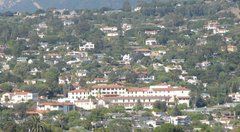
New Urbanism has developed primarily as a response to Post-War suburban sprawl and the damage to many small towns by mega-scale commercial developments. Wal-Mart and the Cul-de-sac are blamed for killing walkable downtowns in favor of malls surrounded by seas of parking and highspeed arterial roadways. The alienation common to these non-places has been linked to racism, vandalism, and even highschool shootings.
Mega retail leverages economies of scale, outsourced product development, and the automobile system to siphon business from traditional civic centers. New shopping centers develop along highways between cities and shopper/residents often move to be even closer to these malls. The scale of these new places often reach urban levels in structures, if not in population.
The old downtowns, now devoid of shops and shoppers - and their eyes, become the secluded haunts of criminals. Shabiness and danger pushes more residents to flee to the suburbs. This reduces central city tax roles and limits possible responses to such social and economic problems.
Suburban clusters of ranch houses oriented towards family-room TVs and fenced backyards limit community interaction and involvement. The new "edge cities" that develop around the shopping centers are not truly public places. Private landlords limit operating hours and can ban certain classes, types, and even individual users by name.
New Urbanist favor a return to the typology of pre-automobile America and Europe. These advocates claim that the built environment shapes human activities and if we wish more traditional civic behaviors then we need more traditional civic designs.
The basic rules for such development have been codified by the Congress For New Urbanism (CNU) and pushed by architects and planners such as Duany Platter-Zyberk. These rules can be reduced to a focus on pedestrians and increased density. They can also be exaggerated into detailed design rules that shape buildings into reproductions of historic styles.
Most architects resist any rules that appear to dictate form. However, it has largely been other rules, those of housing authorities, transit agencies, and banks that have created the suburban norms that the New Urbanists are themselves rebelling against.
Meanwhile global environmental concerns are pushing an end to the auto lifestyle and its attendant strip malls and tract homes. Many consumers and residents are searching for a new direction in urban architecture and cities across America are indeed looking back, to past civic forms, for inspiration.

No comments:
Post a Comment